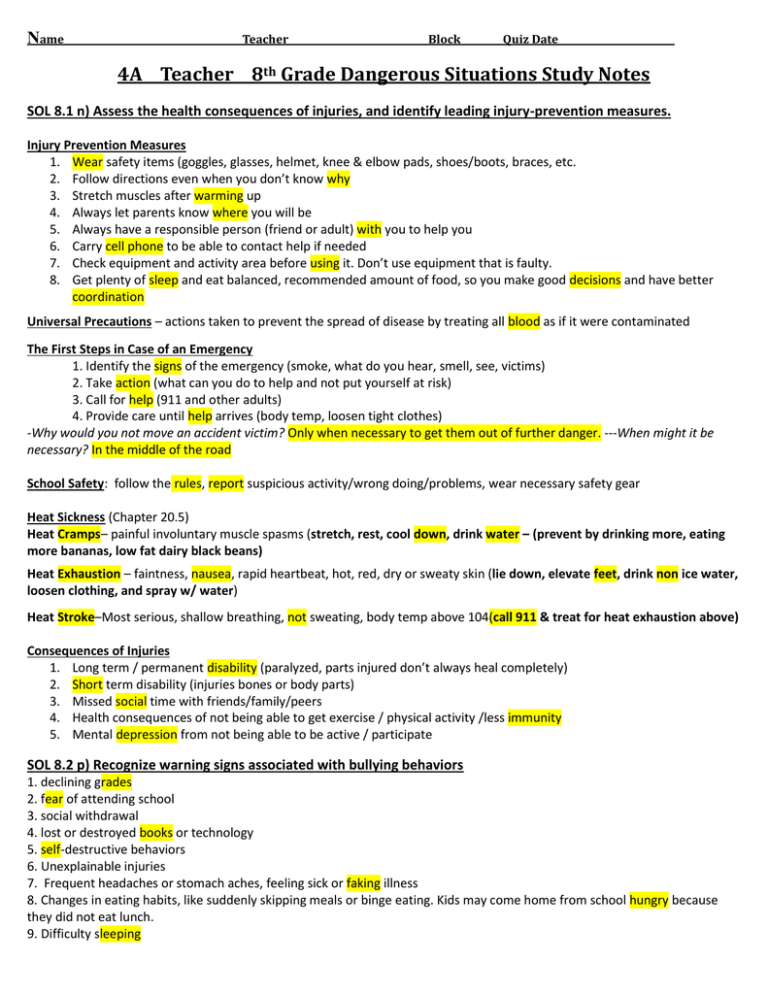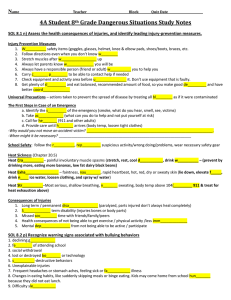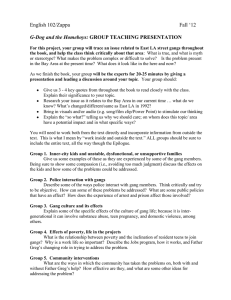4A Teacher 8 N
advertisement

Name ________ Teacher__ _____ _____ __Block_________Quiz Date_________________________ 4A Teacher 8th Grade Dangerous Situations Study Notes SOL 8.1 n) Assess the health consequences of injuries, and identify leading injury-prevention measures. Injury Prevention Measures 1. Wear safety items (goggles, glasses, helmet, knee & elbow pads, shoes/boots, braces, etc. 2. Follow directions even when you don’t know why 3. Stretch muscles after warming up 4. Always let parents know where you will be 5. Always have a responsible person (friend or adult) with you to help you 6. Carry cell phone to be able to contact help if needed 7. Check equipment and activity area before using it. Don’t use equipment that is faulty. 8. Get plenty of sleep and eat balanced, recommended amount of food, so you make good decisions and have better coordination Universal Precautions – actions taken to prevent the spread of disease by treating all blood as if it were contaminated The First Steps in Case of an Emergency 1. Identify the signs of the emergency (smoke, what do you hear, smell, see, victims) 2. Take action (what can you do to help and not put yourself at risk) 3. Call for help (911 and other adults) 4. Provide care until help arrives (body temp, loosen tight clothes) -Why would you not move an accident victim? Only when necessary to get them out of further danger. ---When might it be necessary? In the middle of the road School Safety: follow the rules, report suspicious activity/wrong doing/problems, wear necessary safety gear Heat Sickness (Chapter 20.5) Heat Cramps– painful involuntary muscle spasms (stretch, rest, cool down, drink water – (prevent by drinking more, eating more bananas, low fat dairy black beans) Heat Exhaustion – faintness, nausea, rapid heartbeat, hot, red, dry or sweaty skin (lie down, elevate feet, drink non ice water, loosen clothing, and spray w/ water) Heat Stroke–Most serious, shallow breathing, not sweating, body temp above 104(call 911 & treat for heat exhaustion above) Consequences of Injuries 1. Long term / permanent disability (paralyzed, parts injured don’t always heal completely) 2. Short term disability (injuries bones or body parts) 3. Missed social time with friends/family/peers 4. Health consequences of not being able to get exercise / physical activity /less immunity 5. Mental depression from not being able to be active / participate SOL 8.2 p) Recognize warning signs associated with bullying behaviors 1. declining grades 2. fear of attending school 3. social withdrawal 4. lost or destroyed books or technology 5. self-destructive behaviors 6. Unexplainable injuries 7. Frequent headaches or stomach aches, feeling sick or faking illness 8. Changes in eating habits, like suddenly skipping meals or binge eating. Kids may come home from school hungry because they did not eat lunch. 9. Difficulty sleeping SOL 8.1 p) Identify the consequences of involvement in potentially dangerous situations, such as when weapons, physical violence, and gangs are present. SOL 8.2o Analyze the risks associated with gang-related activities for self, family, & the community. Gangs- Most people when speaking of a gang are referring to a street gang which often recruits kids as young as 8 or 9 to join a “family” for friendship, social ties, and protection. As kids are introduced to the gang, it starts out often with little consequence, but after only days sometimes kids are asked to do illegal or abusive things to continue being a part of the family or to prove loyalty to the gang in return for the friendship and protection. Gangs often hide the illegal activities from the new recruits until they have proven to be loyal to the gang. After showing loyalty to the gang the new recruit is usually dragged into and forced into criminal activity or pay the consequences which is usually abuse of some kind or even death. Youths commit more crimes during the period of active involvement in a gang. Gang members commit more serious crimes than other groups and more than one-fourth of all the homicides (murders) across the country are considered gang-related. Last, gangs tend to propel youths into a life o crime, punctuated by arrests, convictions, and periods of incarceration. Just say “No” to joining any type of group that is like a gang or asks you to do something you shouldn’t to prove you are loyal to the group. Consequences of potentially dangerous situations 1. Jail time 2. Death or long term / permanent disability 3. Short term disability 4. Loss of friends missed social time 5. Physical Abuse 6. Fighting injuries 7. Suspension from School or Sports 8. Grounded by parents Discussion Questions – 1. Have you ever been asked to be part of a group that made you do something that didn’t feel right to be a part of the group? 2. If you were approached to be in a group like this, how would you avoid being in the group? 3. What are the actual words you would say? 4. What do you think the words invincibility and immortality mean? 5. How is the decision making process of adults different than teens, boys/young men compared to girls/young women and what do you think causes the differences? SOL 8.3 j) Identify ways for students to develop relationships that are positive, promote wellness, and prevent gang involvement. You can go and shrink into a corner and hope that someone may notice you, (if they do they will probably think you are not friendly and want to be left alone) or you can: Look for a respected group or person who seem to have interests which you can share. Find out about clubs, groups, sports, music, whatever is happening in your school and join. Helping others is a good way to make friends, so if you see someone who is struggling ask if they would like some help - be kind not bossy. Stand up to bullying. Look for eye contact and smile when someone looks at you. Hang around near a group that looks interesting. Decide what you want to say before you talk, don't just babble on. Listen to the conversation and when you know what is going on join in. Speak in a positive way and don't brag (boast). Look for others who are alone or seem shy and introduce yourself. Ask them about their interests. You may turn out to have a lot in common. Do not hang back and not show you are interested. Don't give up trying to make friends if you're not very lucky at first. Just be yourself, smile and be friendly so that others will want to know you. Others may feel as shy as you do or you may have to find a different group to get friendly with. Keep trying.




